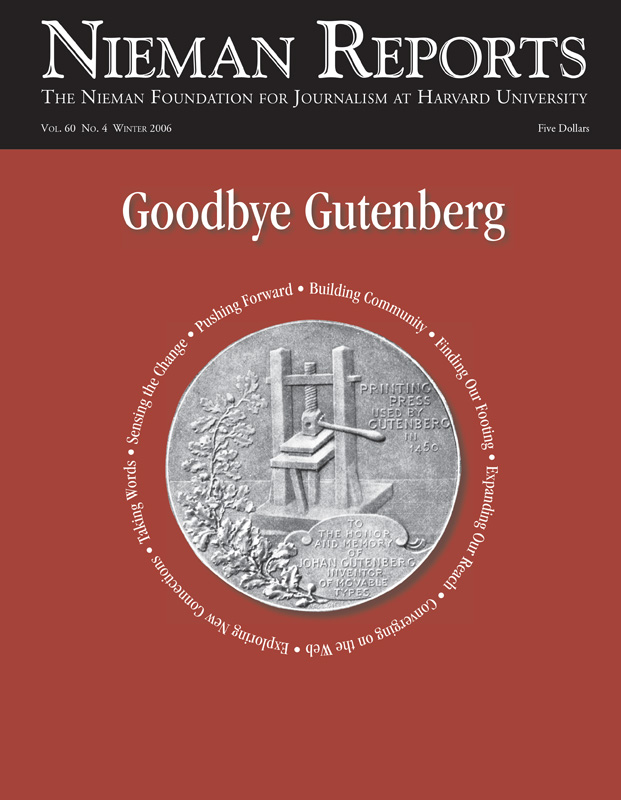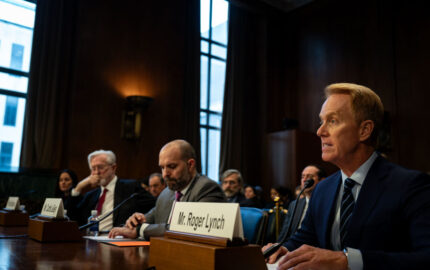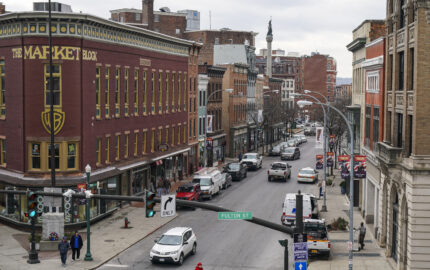
Goodbye Gutenberg
Journalism is on a fast-paced, transformative journey, its destination still unknown. That the Web and other media technologies are affecting mightily the practice of journalism is beyond dispute. Less clear is any shared vision of what the future holds.
In this issue, words about journalists' experiences in the digital era transport our vision forward, while our eye takes us on a visual voyage back to a time when newspapers wove communities together.
Consider the footnote.
Long ignored by reporters and editors, the old-time reference tool might be what newspapers need to lure readers into complex narratives—and show the depth of work such stories require in the newspaper and on the Web. A recent Dallas Morning News narrative series on the financial exploitation of a fading beauty queen convinced even some of our newsroom's skeptics about the value of a device once relegated to academia. The combination of extensive RELATED WEB LINK
Mary Ellen's Will
– www.dallasnews.comfootnotes, source ocuments and historical records and other multimedia elements with cliffhanger storytelling and investigative reporting drew an unprecedented online readership for "Mary Ellen's Will: The Battle for 4949 Swiss."
The four-day, serial narrative tells the story of Mary Ellen Bendtsen and her once grand home on Swiss Avenue, in Dallas's original mansion row. As her looks and memory faded, the octogenarian grew increasingly desperate to hang onto the decaying palace that had been her home for a half century. This meant that Bendtsen was vulnerable when two antique dealers with a history of befriending elderly Dallas residents began tussling with her only daughter. At stake was who would make decisions about her finances, her care and, ultimately, who would inherit her estate.
The tip that led to the project came after the paper published a three-day series on problems in the state's adult protective services system, focusing on the agency's abysmal handling of abuse and neglect cases involving the elderly and disabled in Dallas County. We kept digging for cases that might provide a window for our readers into the financial exploitation of elders. In late March 2005, we heard about the Bendtsen case, which had begun the previous month with a guardianship fight and morphed into a Byzantine will contest lawsuit after she died in early March from complications of a stroke.
Bendtsen's saga had irresistible elements. It revolved around larger-than-life Dallas characters and a Southern gothic plot line that could have been lifted from a Hollywood screenplay. Even early on, it was apparent that the case's intricate legal twists would illustrate the legal system's limited ability to quickly protect vulnerable seniors.
It didn't take long to realize that sorting it out would require dozens of interviews, as well as exhaustive reviews of thousands of pages of court files and transcripts, medical records, and state elder-abuse investigative reports. It would be a challenge to figure out how to explore the characters and their relationships, telling the story of Bendtsen's personal life and her aspiring family's place in an image-conscious city and explain the often-arcane legal issues without overwhelming readers. We knew it was going to take serious reporting before we even had a handle on how we'd know how to get readers to stay with such an intricate story—and keep them coming to it over several days.
Before we got very far, Lee was sent to New Orleans the day before Hurricane Katrina made landfall and ended up spending much of the next six months covering the storm's aftermath. This meant we wouldn't focus on the elder-exploitation series until the end of March 2006.
The Web and Footnotes
After about a month of intensive research and interviews, we agreed on a narrative approach. Then we met with our online colleagues, Karen Davis and Oscar Martinez, to show them the extensive documents and other source material that they could draw from to design the Web presentation. Included were reams of records from Texas Adult Protective Services and local courts that demonstrated how one or both of the antique dealers involved with Bendtsen had previously courted other elderly Dallas residents and ended up with significant chunks of money, houses and, in one case, an estate. We also alerted them to some amazing visuals—Christmas home movies, family photos dating back an entire century, Depression-era modeling shots of Bendtsen, and decades of newspaper and magazine articles detailing her youthful flirtation with fame and her mansion's historic significance.
When we called Poynter Institute writing guru Chip Scanlan for coaching on developing the tale into a mystery serial, complete with daily cliffhangers, he mentioned footnotes as a solution for providing adequate sourcing without bogging down this intricate tale. We already had been thinking about using them, so we looked at other projects that had used footnotes with success. To understand possible pitfalls, we exchanged e-mails with Los Angeles Times reporter Sonia Nazario about her use of them in the 2003 narrative project, "Enrique's Journey." We also visited with Morning News projects editor Maud Beelman about her footnote-reliant investigative work in her previous projects post at the Center for Public Integrity.
News Managing Editor George Rodrigue was also enthusiastic. So we decided to use footnotes for the online edition and later committed to publishing them in print editions of the newspaper. The reasoning: Our traditional readers deserve as much information about sourcing material as our online audience.
Once the idea of using footnotes took hold, we realized that they offered more than just a vehicle for attribution—as they'd been used by other newspapers. They could allow us to provide contextual information and let readers dig deeper into topics of particular interest. We realized, too, that the Web offered another possibility we had not seen used by any newspaper. We could build in "pop-up boxes" so online readers could click on a footnote number in the text and reveal sourcing notes. According to our online colleague, Davis, it could be done by building an html page for each annotation. (By the time the project was published, she had built 133 footnote html pages.)
But we wanted to do even more. We asked Davis to add PDF files of original source documents to these pop-up footnotes. Those would allow readers to explore investigative reports, transcripts, medical records, police reports, wills, deeds and other historic documents that had been amassed in the reporting of the story. This added a level of transparency would leave no doubt about the depth of reporting that went into a story that we wanted to read like good fiction.
After the series was published, Davis and her Web colleagues were amazed at the popularity of the PDF documents. "People wanted the in-depth information," she told us. "They became involved. They wanted more in-depth information."
On each day of the series, the Web edition featured new video elements—ranging from a home movie of Bendtsen's last Christmas to dramatic footage from a hospital emergency room as the antique dealers and their lawyer friend convince Bendtsen to sign a deathbed will. News Web designer Mindy Leichter also created a lush character page, a family "scrapbook" photo album, and other Web elements designed to look like promotional materials for a commercial-run movie. Our videographers added their clips and put together a catchy introductory video segment.
"Because we started early on we were able to put together an experience that fit the story instead of just taking the print content and shoveling it online," Davis says. "Multimedia presentations are successful when you can connect emotionally with someone, immerse them in a reality, and take them through it with an online narrative."
The result was an unparalleled reader response—both online and in print.
Consider a few statistics from dallasnews.com: A recent page-one Sunday news story about the difficulty of keeping track of registered sex offenders drew 2,369 Web page views. That same day, October 1st, breaking news about the Dallas Cowboys trouncing the Tennessee Titans had 6,258 page views. In contrast, "Mary Ellen's Will" drew 7,383 page views on a Saturday afternoon when the first story in the series went up on our Web site; that happened on the day before it was published in our Sunday paper on August 13th. By midnight of that next day, more than 26,000 Web visitors had pulled up the first installment. A midweek Internet chat drew one of the larger live audiences that the News had ever experienced, easily swamping even a recent chat with independent gubernatorial candidate Kinky Friedman. Before week's end, the series and accompanying online multimedia elements had garnered nearly a quarter of a million page views. And by the end of September, the four-part narrative, plus an August 16th postscript and several follow-up stories, had received well over 300,000 page views.
Enthusiastic e-mails arrived by the hundreds. Several included confessions from impatient readers who had tried to hack our Web server because they didn't want to wait for installments that weren't yet posted on our Web site. There were a few harrumphs about "eye-glazing annotations" and "going all David Foster Wallace-ey," but most of those came from journalists.
Many of our newsroom colleagues recognized that something special happened between our readers and us with "Mary Ellen's Will." The overwhelming reader response has strengthened their interest in narrative storytelling. That online readers kept coming back to explore source documents, video clips, and other online elements has also prompted continuing discussions about wider use of footnotes, online multimedia elements, and other Web technology.
Perhaps the most gratifying reaction came from one of the paper's assistant metro editors who'd been skeptical about the idea of footnotes in a daily paper. After reading our day one installment, he called Lee on his day off to declare, "Footnote 32 alone was worth the $1.50 for the Sunday paper!"
Lee Hancock is an enterprise reporter for The Dallas Morning News. Mark Miller was assistant managing editor for Sunday and enterprise reporting at The Dallas Morning News from May 2004 until October 2006, when he was named assistant managing editor of Newsweek. He now works in New York.
Long ignored by reporters and editors, the old-time reference tool might be what newspapers need to lure readers into complex narratives—and show the depth of work such stories require in the newspaper and on the Web. A recent Dallas Morning News narrative series on the financial exploitation of a fading beauty queen convinced even some of our newsroom's skeptics about the value of a device once relegated to academia. The combination of extensive RELATED WEB LINK
Mary Ellen's Will
– www.dallasnews.comfootnotes, source ocuments and historical records and other multimedia elements with cliffhanger storytelling and investigative reporting drew an unprecedented online readership for "Mary Ellen's Will: The Battle for 4949 Swiss."
The four-day, serial narrative tells the story of Mary Ellen Bendtsen and her once grand home on Swiss Avenue, in Dallas's original mansion row. As her looks and memory faded, the octogenarian grew increasingly desperate to hang onto the decaying palace that had been her home for a half century. This meant that Bendtsen was vulnerable when two antique dealers with a history of befriending elderly Dallas residents began tussling with her only daughter. At stake was who would make decisions about her finances, her care and, ultimately, who would inherit her estate.
The tip that led to the project came after the paper published a three-day series on problems in the state's adult protective services system, focusing on the agency's abysmal handling of abuse and neglect cases involving the elderly and disabled in Dallas County. We kept digging for cases that might provide a window for our readers into the financial exploitation of elders. In late March 2005, we heard about the Bendtsen case, which had begun the previous month with a guardianship fight and morphed into a Byzantine will contest lawsuit after she died in early March from complications of a stroke.
Bendtsen's saga had irresistible elements. It revolved around larger-than-life Dallas characters and a Southern gothic plot line that could have been lifted from a Hollywood screenplay. Even early on, it was apparent that the case's intricate legal twists would illustrate the legal system's limited ability to quickly protect vulnerable seniors.
It didn't take long to realize that sorting it out would require dozens of interviews, as well as exhaustive reviews of thousands of pages of court files and transcripts, medical records, and state elder-abuse investigative reports. It would be a challenge to figure out how to explore the characters and their relationships, telling the story of Bendtsen's personal life and her aspiring family's place in an image-conscious city and explain the often-arcane legal issues without overwhelming readers. We knew it was going to take serious reporting before we even had a handle on how we'd know how to get readers to stay with such an intricate story—and keep them coming to it over several days.
Before we got very far, Lee was sent to New Orleans the day before Hurricane Katrina made landfall and ended up spending much of the next six months covering the storm's aftermath. This meant we wouldn't focus on the elder-exploitation series until the end of March 2006.
The Web and Footnotes
After about a month of intensive research and interviews, we agreed on a narrative approach. Then we met with our online colleagues, Karen Davis and Oscar Martinez, to show them the extensive documents and other source material that they could draw from to design the Web presentation. Included were reams of records from Texas Adult Protective Services and local courts that demonstrated how one or both of the antique dealers involved with Bendtsen had previously courted other elderly Dallas residents and ended up with significant chunks of money, houses and, in one case, an estate. We also alerted them to some amazing visuals—Christmas home movies, family photos dating back an entire century, Depression-era modeling shots of Bendtsen, and decades of newspaper and magazine articles detailing her youthful flirtation with fame and her mansion's historic significance.
When we called Poynter Institute writing guru Chip Scanlan for coaching on developing the tale into a mystery serial, complete with daily cliffhangers, he mentioned footnotes as a solution for providing adequate sourcing without bogging down this intricate tale. We already had been thinking about using them, so we looked at other projects that had used footnotes with success. To understand possible pitfalls, we exchanged e-mails with Los Angeles Times reporter Sonia Nazario about her use of them in the 2003 narrative project, "Enrique's Journey." We also visited with Morning News projects editor Maud Beelman about her footnote-reliant investigative work in her previous projects post at the Center for Public Integrity.
News Managing Editor George Rodrigue was also enthusiastic. So we decided to use footnotes for the online edition and later committed to publishing them in print editions of the newspaper. The reasoning: Our traditional readers deserve as much information about sourcing material as our online audience.
Once the idea of using footnotes took hold, we realized that they offered more than just a vehicle for attribution—as they'd been used by other newspapers. They could allow us to provide contextual information and let readers dig deeper into topics of particular interest. We realized, too, that the Web offered another possibility we had not seen used by any newspaper. We could build in "pop-up boxes" so online readers could click on a footnote number in the text and reveal sourcing notes. According to our online colleague, Davis, it could be done by building an html page for each annotation. (By the time the project was published, she had built 133 footnote html pages.)
But we wanted to do even more. We asked Davis to add PDF files of original source documents to these pop-up footnotes. Those would allow readers to explore investigative reports, transcripts, medical records, police reports, wills, deeds and other historic documents that had been amassed in the reporting of the story. This added a level of transparency would leave no doubt about the depth of reporting that went into a story that we wanted to read like good fiction.
After the series was published, Davis and her Web colleagues were amazed at the popularity of the PDF documents. "People wanted the in-depth information," she told us. "They became involved. They wanted more in-depth information."
On each day of the series, the Web edition featured new video elements—ranging from a home movie of Bendtsen's last Christmas to dramatic footage from a hospital emergency room as the antique dealers and their lawyer friend convince Bendtsen to sign a deathbed will. News Web designer Mindy Leichter also created a lush character page, a family "scrapbook" photo album, and other Web elements designed to look like promotional materials for a commercial-run movie. Our videographers added their clips and put together a catchy introductory video segment.
"Because we started early on we were able to put together an experience that fit the story instead of just taking the print content and shoveling it online," Davis says. "Multimedia presentations are successful when you can connect emotionally with someone, immerse them in a reality, and take them through it with an online narrative."
The result was an unparalleled reader response—both online and in print.
Consider a few statistics from dallasnews.com: A recent page-one Sunday news story about the difficulty of keeping track of registered sex offenders drew 2,369 Web page views. That same day, October 1st, breaking news about the Dallas Cowboys trouncing the Tennessee Titans had 6,258 page views. In contrast, "Mary Ellen's Will" drew 7,383 page views on a Saturday afternoon when the first story in the series went up on our Web site; that happened on the day before it was published in our Sunday paper on August 13th. By midnight of that next day, more than 26,000 Web visitors had pulled up the first installment. A midweek Internet chat drew one of the larger live audiences that the News had ever experienced, easily swamping even a recent chat with independent gubernatorial candidate Kinky Friedman. Before week's end, the series and accompanying online multimedia elements had garnered nearly a quarter of a million page views. And by the end of September, the four-part narrative, plus an August 16th postscript and several follow-up stories, had received well over 300,000 page views.
Enthusiastic e-mails arrived by the hundreds. Several included confessions from impatient readers who had tried to hack our Web server because they didn't want to wait for installments that weren't yet posted on our Web site. There were a few harrumphs about "eye-glazing annotations" and "going all David Foster Wallace-ey," but most of those came from journalists.
Many of our newsroom colleagues recognized that something special happened between our readers and us with "Mary Ellen's Will." The overwhelming reader response has strengthened their interest in narrative storytelling. That online readers kept coming back to explore source documents, video clips, and other online elements has also prompted continuing discussions about wider use of footnotes, online multimedia elements, and other Web technology.
Perhaps the most gratifying reaction came from one of the paper's assistant metro editors who'd been skeptical about the idea of footnotes in a daily paper. After reading our day one installment, he called Lee on his day off to declare, "Footnote 32 alone was worth the $1.50 for the Sunday paper!"
Lee Hancock is an enterprise reporter for The Dallas Morning News. Mark Miller was assistant managing editor for Sunday and enterprise reporting at The Dallas Morning News from May 2004 until October 2006, when he was named assistant managing editor of Newsweek. He now works in New York.


